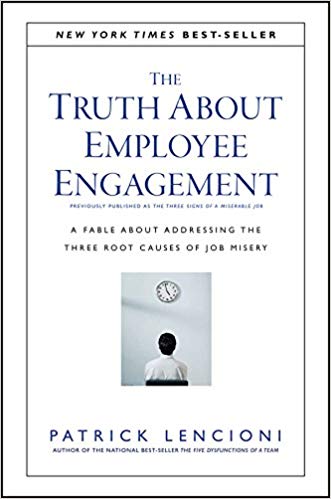Book review: The Truth About Employee Engagement
 Although this is now the fourth book by Patrick Lencioni that I’ve read, I wouldn’t necessarily label myself as a fan. His typical presentation format of beginning with a fable (in this case, 213 pages worth) that illustrates his principles and then following that with a relatively brief portion (40 pages) explicitly describing his model still makes me question whether that’s the most effective use of time and space.
Although this is now the fourth book by Patrick Lencioni that I’ve read, I wouldn’t necessarily label myself as a fan. His typical presentation format of beginning with a fable (in this case, 213 pages worth) that illustrates his principles and then following that with a relatively brief portion (40 pages) explicitly describing his model still makes me question whether that’s the most effective use of time and space.
That being said, I found the fable in The Truth About Employee Engagement: A Fable About Addressing the Three Root Causes of Job Misery the best of any of his that I’ve so far encountered—the most believable, least contrived and also with more explicitly Christian references. As I understand it, Lencioni is a believer, but the most direct references to faith are usually reserved for the concluding comments in his acknowledgements.
One of the final sections of this book is entitled “The Ministry of Management,” where Lencioni makes some specific references to notions of serving others and embracing the gifts of God; this makes for a helpful and concrete reminder of the underpinnings of faith which exist at the foundation of a message which can easily be ingested by a secular audience.
Perhaps because of my personal season of life, I found the model and content presented in this work to be the best of his attempts to provide language, categories and insight in navigating organizational dynamics. This book was originally published with the title “The Three Signs of a Miserable Job” which I find even more appropriate than its revised title; this is a book aimed at managers, so not so much about employees getting engaged in an endeavor, but rather the manager’s critical role in engaging with employees.
I’ll let you discover Lencioni’s “Three Signs” for yourself, but I found them to be accurate descriptors of where some of my current disenchantment with my present ministry role stem from, while simultaneously challenging me as I oversee and support others in their ministries.
I could see this book being useful at various levels of church and para-church ministry. Elder boards and senior pastors will be challenged in how they relate to the individuals that they supervise and work most closely with.
A small groups pastor would be encouraged to engage with intentionality in connecting with the various home group leaders that form the crux of such a ministry, helping to ensure that their service is felt to be meaningful and effective. Various other assistants, team leaders, committee chairpersons and department heads would be blessed if their supervisors dedicated energy to ensuring that the three signs of job/ministry misery become transformed into three opportunities for encouragement.
People are the fundamental resource of the kingdom of God and the body of Christ, and all who are given a stewardship of supervision would be aided in their role by considering the framework shared in this relatively short, accessible, insightful work.
More on Leadership Development & Discipleship
- What I learned from Jim Harbaugh about how to attack the day (by Tom Crenshaw)
- This may be why God hasn’t answered your prayer… (by Jordan Raynor)
- VIDEO: Church attenders are scattered. Here’s one fix that brings them together. (by Bob Whitesel)
- Responding to God’s activity in America (by Richard Blackaby)


